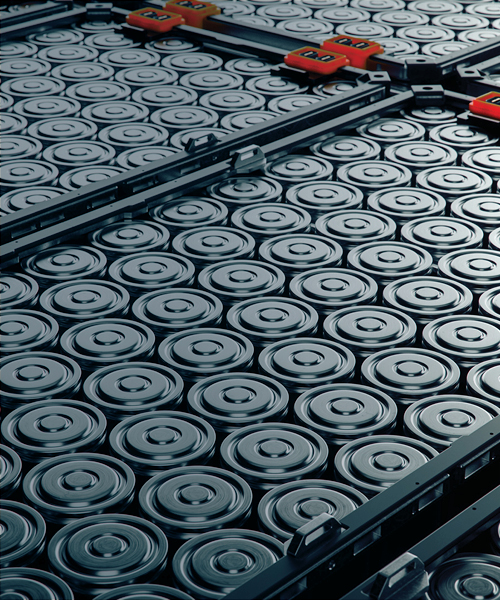May 20, 2025 • 6 mins read
Leading with innovation,
not replication:
India’s battery industry is at a crossroads
India is at a pivotal moment in its journey to becoming a global leader in electric vehicles (EVs) and energy storage. As the country accelerates its transition to cleaner energy sources, the demand for lithium-ion batteries is expected to surge, with estimates suggesting a requirement of 150 to 200 GWh by 2030. This presents a significant opportunity for India to build a robust domestic battery manufacturing ecosystem – but also brings major challenges that must be addressed to ensure long-term success.
Realizing India’s battery manufacturing potential
Currently, India relies heavily on imports for raw materials; key intermediates such as precursor for cathode active material (pCAM), cathode active material (CAM), anode active material (AAM), and electrolytes; as well as electrodes, battery cells, and finished battery packs.
“This dependence is similar to the country’s reliance on crude oil, highlighting the need for strategic investments in local manufacturing,” says Yatin Mahajan, Operations Director – Batteries at Worley’s Mumbai office. “Building a self-sufficient supply chain – from raw material processing to gigafactories producing battery cells and packs – is crucial to reducing vulnerabilities and strengthening India’s energy security.”
India has several inherent advantages to support this transformation including cost-competitive manufacturing capabilities, experience in complex industrial gigafactories, moderate energy prices and a growing pool of skilled labor. “However, addressing supply chain inefficiencies, advancing technology capabilities, and creating a favorable regulatory environment will be key to fully realizing this potential,” says Mahajan.
Avoiding the pitfalls of replication without localization
China currently leads the global battery value chain – from raw material sourcing and processing of key intermediates to the assembly of final battery packs – while also driving advancements in battery technologies. Many Indian manufacturers are considering Chinese technology as a starting point to scale up production. However, as we’ve seen elsewhere in the world, a direct cut-paste approach is unlikely to succeed.
![]()
…a direct cut-paste approach is unlikely to succeed.
“We’ve seen in global projects that simply adopting China’s technology, capital, and operating cost assumptions can lead to significant challenges,” says Mahajan. “Raw material pricing, supply chain constraints, local energy and labor costs, quality variations, waste management, HSE regulations, and building codes – all of these local factors have major impacts on project economics and must be carefully considered.”
For example, battery gigafactories in Europe and North America have faced unexpected hurdles when adapting Chinese technology to local conditions. These learnings are critical for India, where regulatory, construction and operational environments differ significantly from China.
"Worley’s global team, including offices in India and China, have played key roles in Western battery projects, providing valuable insight into how global best practices can be effectively adapted,” says Mahajan. “Our combined expertise enables us to support Indian manufacturers in navigating local challenges, de-risk investments and optimize technology adoption for long-term success.”
Strategic opportunities for India’s lithium-ion battery sector
Government initiatives are already shaping the future of India’s battery industry. Policies such as the Production-Linked Incentive (PLI) scheme, which provides financial incentives to domestic manufacturers, are fostering investment and innovation in the sector.
Geopolitical stability, relatively low labor costs and expanding infrastructure provide a strong foundation to attract investment. “Furthermore, India’s focus on sustainability offers an opportunity to integrate advanced recycling technologies and build a circular economy for battery materials, reducing long-term dependence on raw material imports,” says Mahajan.
While government policies and global investment opportunities provide a promising foundation, India must focus on several key priorities to truly build a competitive and sustainable battery manufacturing ecosystem.
Key priorities for a sustainable and competitive industry
India must reduce its reliance on imported materials by developing domestic production capabilities for key inputs such as lithium carbonate, lithium hydroxide, and cathode/anode feedstock materials. Establishing local processing is essential for insulating the sector from global price shocks and geopolitical disruptions. Furthermore, having a strong domestic manufacturing base will allow India to stay aligned with the rapid pace of global technological advancements, ensuring it remains competitive in the evolving battery sector.
While India benefits from lower labor and operational costs compared to Western markets, these advantages alone won’t be enough to ensure long-term success. “To fully capitalize on this, the country must invest in technology development and automation to enhance productivity and ensure globally competitive quality standards,” says Mahajan. A focus on innovation and efficiency will be vital for India to build a sustainable cost advantage and maintain its competitiveness in the global battery value chain.
India must also take a strategic approach to international collaboration, particularly given that many global battery leaders are based in China, South Korea, and Japan. Rather than simply licensing technology, Indian firms should prioritize forming partnerships that grant access to advanced manufacturing expertise, research capabilities, and valuable supply chain insights. These partnerships will enable Indian manufacturers to scale efficiently, avoid common industry pitfalls and ensure knowledge transfer, ultimately accelerating the adoption of best practices.
As electric vehicle adoption rises, building a circular economy for battery materials will be a critical part of India's strategy. By investing in battery recycling infrastructure, the country can recover essential minerals like lithium, cobalt, and nickel from end-of-life batteries. This will not only reduce dependence on imported raw materials but also contribute to a more sustainable and resilient battery supply chain in the long run.
Finally, research and development will play a crucial role in driving India’s growth in the battery sector. Breakthroughs in energy storage efficiency, battery longevity, and sustainable production methods will be key to ensuring the country remains competitive on the global stage. By strengthening its R&D capabilities, India can become a leader not just in manufacturing but also in innovation within the global battery industry.
Applying global insights to India’s battery industry
“While India is gearing up to scale its lithium battery production, global markets offer valuable insights that can influence/inform our path forward,” says Mahajan. “Europe, for example, faces challenges as it tries to catch up with Asia’s fast-growing battery industry.” To accelerate India's battery manufacturing success, we can reflect on key global insights we can build on:
- Speed to market vs scaling-up methodologies: “Too often we observe an under appreciation of scale-up methodologies,” says Mahajan. Scaling up any technology is fraught with risks and in the rush to accelerate first revenue, customers may overlook a structured methodology, or rush key steps to bring production online faster.
- Avoiding late-stage technology changes: “Many leadership teams underestimate the impact of late-stage ‘improvements’,” says Mahajan, often leading to quality issues, cost overruns, and schedule disruptions.
- Ramp-up to full production capacity: “We've been brought into de-bottleneck plants around the world stuck at low capacity or struggling with high scrap rates—resulting in daily losses worth tens of millions of dollars. Even seasoned executives’ wince at those numbers,” says Mahajan. Successfully ramping up to full production capacity is vital for profitability.
- Collaboration across the supply chain: Effective collaboration among technology providers, equipment suppliers and contractors are crucial for ensuring the timely delivery of specialized equipment.
- Realistic project timelines and capex considering local factors: Overly ambitious timelines and incorrect early capex estimates, often driven by poorly structured agreements or pressure to meet deadlines, can lead to delays and budget overruns.
- Multiple stakeholder relationship: Misalignment on scope, battery limits, guarantees, validations and ownership across stakeholders – including the customer, project managers, engineers, licensors, OEMs and contractors) is a key challenge as projects advance.
- Environmental and waste management: As environmental regulations become increasingly stringent, managing waste streams and by-products like sodium sulfate from CAM (catalytic activated methanol) plants, requires a strategic approach to ensure compliance and minimize environmental impact.
India’s battery manufacturers can benefit from global experience to avoid costly mistakes and accelerate growth.
The path forward
India stands at a crossroads in shaping the future of its lithium-ion battery industry. “Success will depend on strategic decision-making, disciplined execution, and the ability to leverage learnings from global markets,” says Mahajan. By investing in local supply chain capabilities, fostering technology partnerships, and prioritizing workforce development, India can position itself as a major player in the global battery economy – securing its energy future while contributing to the global transition towards clean energy.
India can build a world-class battery manufacturing industry, but achieving this goal requires commitment, collaboration, and a long-term vision. “With the right strategic approach and global engineering partner, India can move beyond being a consumer of lithium-ion batteries to becoming a global leader in their production, setting the stage for a cleaner, more sustainable energy future.”




